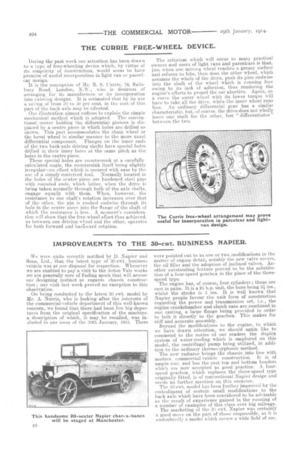THE CURRIE FREE-WHEEL DEVICE.
Page 30

If you've noticed an error in this article please click here to report it so we can fix it.
During the past week our attention has been drawn to a type of free-wheeling device which, by virtue of its simplicity of Construction, would seem to have promise of useful incorporation in light van or paredcar design.
It is the conception of Mr. R. S. Currie, 76, Salisbury Road, London, N.W., who is desirous of arranging for its manufacture or its incorporation into existing designs. It is estimated that by its use a saving of from 30 to 30 per cent. in the cost of this part of the back axle may be effected.
Our illustration almost suffices to explain the simple mechanical method which is adopted. The conventional centre holding the differential pinions is displaced by a centre piece in which holes are drilled as shown. This part accommodates the chain wheel or the bevel wheel in similar manner to the more usual differential component. Flanges on the inner ends of the two back-axle driving shafts have special holee drilled in their inner faces at the same pitch as the holes in the centre piece. These special holes are countersunk at a carefullycalculated angle, the countersink itself being slightiy irregular—an effect which is secured with ease by the use of a simply-contrived tool. Normally located in the holes of the centre piece are hardened steel pins with rounded ends, which latter, when the drive is being taken normally through both of the axle shafts, engage equally with them. When, however, the resistance to one shaft's rotation increases over that of the other, the pin is pushed endwise through its hole in the centre piece into the flange of the shaft of whichthe resistance is less. A moment's consideration will show that the free-wheel effect thus achieved. a-s between one driving wheel and the other, operates for both forward and backward rotation. The criticism which will occur to many practical owners and users of light vans and parcelcars is that, just when one driving wheel reaches a greasy surface and refuses to bite, then does the other wheel, which assumes the whole of the drive, push its pins endwise into the shaft of the wheel which is running free owing to its lack of adhesion, thus rendering the engine's efforts to propel the car abortive. Again, on a curve the outer wheel with its lower torque will. have to take all the drive, while the inner wheel runs free. An ordinary differential gear has a similar characteristic, but, of course, the drive does not wholly leave one shaft for the other, but " differentiates ". between the two.






































